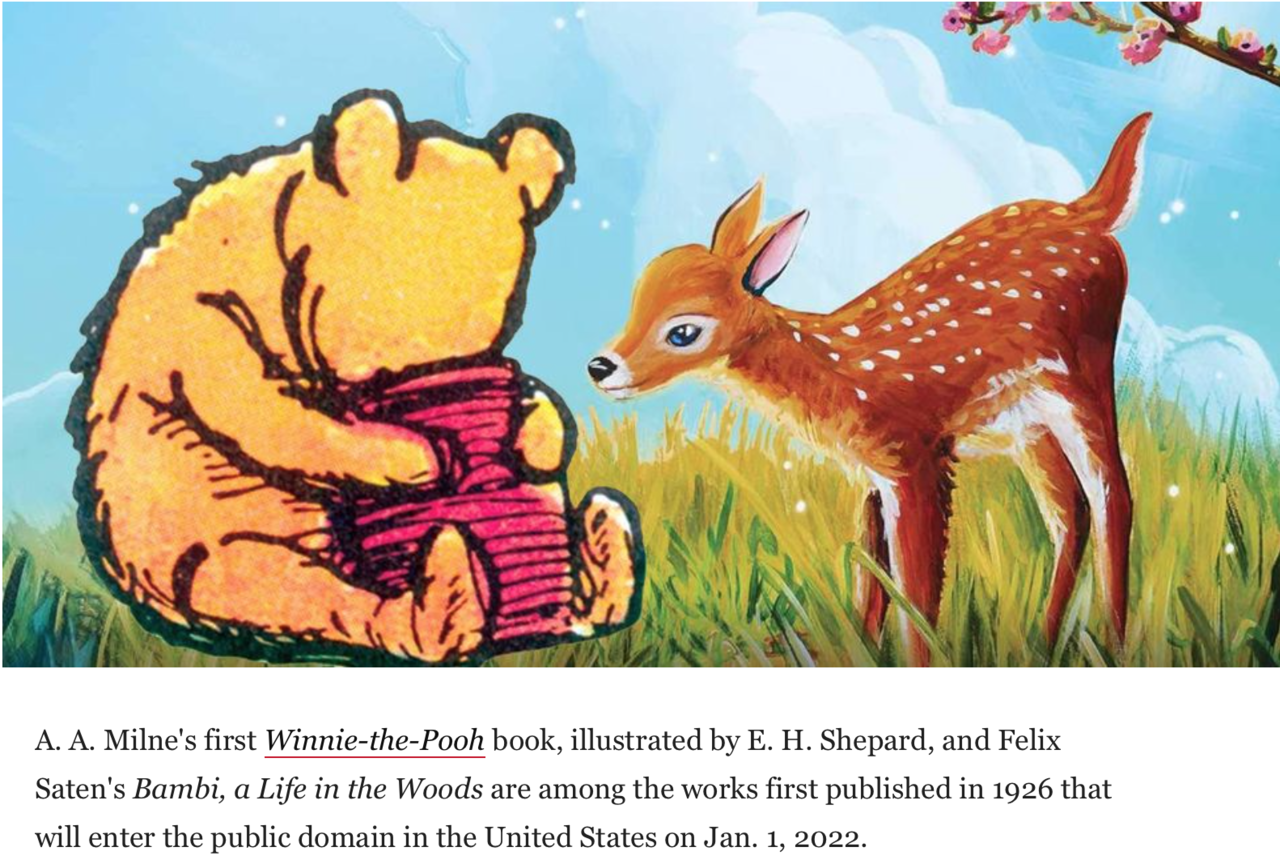Oh, Pooh! What do we do now?
 On January 1st of each year, a new crop of artistic works, such as movies, books, poems and music, enter the Public Domain. This means that anyone can use the material contained within the public domain work without having to obtain permission of the copyright owner or pay a royalty, because the copyright has expired. Under the U.S. Copyright Law, the owners right to copy, distribute, display and control derivative rights no longer exists.
On January 1st of each year, a new crop of artistic works, such as movies, books, poems and music, enter the Public Domain. This means that anyone can use the material contained within the public domain work without having to obtain permission of the copyright owner or pay a royalty, because the copyright has expired. Under the U.S. Copyright Law, the owners right to copy, distribute, display and control derivative rights no longer exists.
In 2022, works created in 1926 entered the public domain, with Ernest Hemingway, Agatha Christie and Felix Salton taking a hit. Included within this auspicious group is one of the most valuable franchises of all time-WINNIE THE POOH! A. A. Milne’s classic children’s tale of the Hundred-Acre Wood was published in 1926, and included appearances by the lovable Winnie-the-Pooh, Piglet, Eeyore, Rabbit, Kanga, Roo, Owl and Christopher Robin. His hopping pal Tigger was not introduced until 1928, so he’s still protected by the copyright laws.
We all know that Disney licensed Pooh’s rights from the Slesinger family, which purchased the rights from the Milne estate. Subsequently, Disney turned the cuddly bear into a franchise juggernaut. It is reported by Statisca that in 2021, Pooh ranked Number 3 in the top-grossing media franchises, after Pokemon ($100M) and Hello Kitty ($84.5M), and he’s tied with another Disney icon Mickey Mouse ($80.3M).
The question arises as to what are the licensing rightholder’s (Disney’s) legal rights when the copyright on the underlying material has expired and has entered the public domain. Under the law, Disney only possesses rights to any new material which it contributed to the work known as “derivative rights.” Those rights are secondary to the original Pooh material. In the instance of a book like Winnie-the-Pooh, the derivative works could be movies, songs, coloring books, or plays based upon the original copywritten material.
Therefore, because of the public domain, anyone can now use the original illustrations of E. H. Shepard and story contained in Winnie-the-Pooh, or reprint the original books, or create new art or stories based upon the original story. Keep in mind that Disney retains the copyrights on later books and movies, including Tigger, as well as the trademarks on a variety of Pooh products.
What happens when trademarks and copyrights overlap so that they cover the same material? Although it may be confusing, the distinction between the two rights is that copyrights protects artistic works and trademarks protects commercial products. Parenthetically, patents protect scientific and manufacturing innovations. To our point, a trademark is a logo that serves to brand a product, like Oreo Cookies, Quaker Oats, Mickey Mouse, and yes, Winnie-the-Pooh. The U.S Supreme Court has held that trademarks cannot be used to artificially extend the life of an expired copyright, so where does that leave poor Pooh?
The answer is complicated. There is a difference between using Pooh as a “brand identifier” as opposed to him appearing in a book or movie or as a merely decorative image on a product. So long as there is no confusion in the marketplace that the new Pooh products are manufactured by you, and not products licensed by Disney, there shouldn’t be a problem. Go ahead and put Pooh on a t-shirt and wear him proudly. Just make sure that the public knows that you aren’t holding yourself out as being part of Disney’s clothing line.
However, we are in new, developing territory with Pooh Bear. We can expect the copyright-trademark quandary to intensify as the cartoon “Steam Boat Willie,” the ancestor of Mickey Mouse, enters the public domain in 2024. Some very interesting copyright law will develop as we witness how far Disney will go to protect it’s intellectual property.
In conclusion, as writers, we are free to retell the tale of Pooh and his friends using the original plot, dialogue and characters, or we can create our own new works or creative expressions. Let Pooh spark our creative juices. The public domain provides us with license to do so. However, do tread lightly when using Pooh, Eeyore or Piglet on the mass production of pajamas, lunchboxes and backpacks, because Disney may be watching!